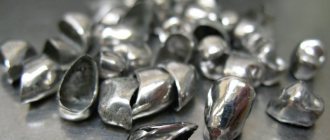Pediatric dentistry can be considered a separate section of modern dental practice, because due to the structural features, the treatment of baby teeth is somewhat different from the treatment of permanent teeth. Unfortunately, many parents are still convinced that baby teeth do not need dental care - after all, they will soon break down and fall out anyway. Therefore, children are not taken to the dentist very often, and if they are taken to the doctor, it is with advanced diseases and multiple problems.
In fact, dental treatment should be carried out at any age, and the sooner you consult a doctor with a problem, the higher the likelihood of getting rid of it quickly and without any complications. If a child has bad baby teeth, this will inevitably affect the health of his permanent ones - this is what parents need to remember when they want to “pity” the baby and not take him to an appointment with the “evil dentist.”
Gum inflammation
The most common inflammatory gum diseases in children are stomatitis and gingivitis. Stomatitis, or, as it is usually called, thrush, is an infectious inflammatory process provoked by fungi of the genus Candida. Treatment is antifungal and anti-inflammatory therapy, always carried out under the supervision and recommendations of a dentist. Self-medication can be dangerous, as some children may have allergic reactions to certain medications or antiseptics.
Gingivitis most often occurs due to plaque on baby teeth and insufficient general hygiene, but the reasons for their development can also be trauma to the gums during teething or other injuries, untreated caries. With this problem, you also need to contact a doctor, who will select the optimal treatment regimen and prevent gingivitis from developing into childhood periodontitis.
What types of fillings are there (temporary, permanent)
Depending on the purpose, fillings can be temporary or permanent. Temporary fillings are used for diagnosis and treatment. For example, a dentist will place a temporary filling to ensure that the nerve is affected. If after a certain time the patient experiences pain, the nerve must be removed. The doctor also applies a temporary filling if it is necessary to hide any medicine for a certain period. After this period, the doctor himself, without much effort, removes the temporary filling in order to replace it with a permanent one.
Permanent fillings should restore the anatomical shape of the tooth, its functionality and serve for many years.
Caries, pulpitis and periodontitis of primary teeth in children
Milk teeth have thinner enamel and dentin layers than permanent teeth, they have a larger pulp chamber and, therefore, infection spreads faster to the pulp. They are more often susceptible to carious lesions - and not least because of night feeding or the habit of drinking drinks from a bottle at night (mostly sweet or sweetened - tea, juices).
In addition, caries is often provoked by plaque on baby teeth, which forms faster than in adults, and which not all parents are in a hurry to remove. Many people begin brushing their children’s teeth at a more or less conscious age, while a child should be taught hygiene and regularly remove plaque from the moment the first teeth erupt, that is, from about six months of age. Also, the cause of diseases of the dental system can be an insufficient amount of solid food in the baby’s diet, since chewing solid food helps to clean the dental surfaces themselves.
The child's nutritional habits, lack of hygiene, and too thin enamel layer provoke a phenomenon called circular caries of baby teeth - carious lesions spread over the entire tooth surface, as if encircling the crown.
Caries quickly turns into pulpitis - an inflammatory lesion of the dental pulp. Most often, a doctor is consulted precisely at this stage of the infectious process, ignoring the initial stages of damage to dental tissues. Pulpitis, in turn, provokes periodontitis of primary teeth in children - inflammation of the periodontal tissues near the tips of the tooth roots. This condition is usually accompanied by severe pain, severe swelling of the affected area, and often an increase in body temperature.
Filling or silver plating
Silver ions stop the growth and division of pathogenic microorganisms. This means that caries will not develop in the future. But silvering is prescribed only in the initial stages of the disease. When large areas are damaged, it is useless to silver a baby tooth; over time, it will still collapse. A puncture may occur, which certainly will not be pleasant for the baby.
Is it possible to do a filling without a drill?
Today, medicine has made great progress and dentistry is no exception. Our clinic has ultra-modern equipment that does not produce frightening noisy sounds. In addition, filling is currently performed chemically. Its essence is the application of a special gel-like substance, which, after 30 minutes of exposure, is removed along with the damaged tissues. Then filling material is applied to this place.
Anesthesia
In order not to traumatize the psyche of children, dentists use injections extremely rarely. Pain-relieving gels and sprays are mainly used. Injection anesthesia is used only in extreme cases.
Anesthetics are selected in each individual case and are used only when there are no contraindications.
Causes of caries
- artificial feeding;
- genetic predisposition;
- poor nutrition (lack of sufficient fluoride in the diet),
- injuries;
- defects, features of the anatomical structure of bone tissue;
- poor oral hygiene;
If the development of the disease is associated with inheritance or poor health, it is necessary to regularly show the child to the pediatric dentist.
Treatment of baby teeth
At the initial stages, caries is treated without tissue preparation - remineralization of the enamel, as well as modern Icon technology, which allows filling without drilling, easily cope with carious lesions of the enamel layer. In later stages, when the dentinal layer is affected, as well as in the case of pulpitis and periodontitis, treatment of baby teeth with tissue preparation will be required. You should not be afraid of such procedures - modern methods of anesthesia allow them to be carried out completely painlessly and comfortably for a small patient. In addition, the anesthetics used are harmless, with a minimum concentration of the active substance. And the site of the upcoming injection itself is numbed by applying a special gel or spray (application anesthesia).
Experienced dentists try to carry out treatment quickly so that the child does not have time to get tired and capricious. If a child has bad baby teeth and a large amount of work is required, it is divided into several stages. It also happens that the child does not want to contact the doctor, is too afraid of treatment, or the volume of manipulation is too large and serious - in such a situation, it is possible to carry out therapy under anesthesia or with intravenous sedation (with a preliminary examination).
In case of pulpitis, the root canals are filled with special pastes that dissolve simultaneously with the “milky” root, so there is no chance that the medicinal material will remain in the tooth socket and will prevent the new tooth from growing properly.
Is it necessary to treat baby teeth and put fillings in them?
Baby teeth have a number of features that need to be taken into account. Milk (temporary) teeth are located in the area of the buds of permanent teeth. Any inflammation in a baby tooth, if left untreated, can affect the development and health of the child's permanent tooth bud.
If you find caries on a child’s baby tooth, there is no need to delay treatment and installation of a filling. You can lose not only a baby tooth, but also damage the germ of a permanent tooth.
Processes that occur in a child’s body are much faster than in an adult. If treatment for caries (a black spot on a tooth or a small hole) is not started in time, the inflammatory process of the pulp develops very quickly - pulpitis (inflammation of the neurovascular bundle inside the tooth).
If you continue with pulpitis, there is a risk of developing periodontitis (inflammation of the tissue around the tooth). And then the germ of a permanent tooth may die. We recommend that you do not delay your visit to the pediatric dentist in order to identify and treat caries in time.
What features do baby teeth have?
- Baby teeth have less dentin and hard tissue, and a thinner layer of enamel
- The dentinal tubules in baby teeth are wider, so the permeability to infection is higher, and inflammatory processes occur faster
- Special materials are used to treat baby teeth. Early loss of baby teeth, good or bad?
If it happened that you lost a baby tooth ahead of time, what could be the consequences?
- The rudiments of permanent teeth begin to move, occupying free space.
- The position of the permanent tooth in the dentition changes, which leads to crowding of the teeth.
- The aesthetics of the dentition and smile are changing.
- Diction may change.
All of the above leads to the need to correct the bite using braces or other structures.
Colored fillings for children
Colored fillings for children are produced by the German company Twinky Star, which has developed a special material suitable for children's baby teeth. By creating bright colors for fillings, the manufacturer has made dental treatment more fun and interesting. When a child chooses the color he likes, he interacts with the doctor and influences the treatment process. This allows you to create trust between the doctor and the patient and helps with further treatment.
The child can choose one of seven colors to install the filling:
- Yellow
- Pink
- Orange
- Green
- Gold
- Blue
- Silver
Children love to choose the color they like best, for example, boys choose blue or green, and girls choose orange or gold. In addition, there are also fillings with glitter, which will appeal to many children.
Features of MULTI-COLORED SEALINGS
In addition to their bright and attractive appearance, colored fillings have a number of advantages:
- Fillings are made from a material called compomer, containing glass ionomers and photopolymers
- Excellent indicators of biocompatibility and adhesion (marginal fit) of the material
- Colored fillings have a service life of 3 years or more, which is often sufficient for baby teeth
- Abrasion resistance, durability. Bright colors help to quickly and easily diagnose the abrasion of the filling; even the child’s parents can do this simply by looking into the child’s mouth.
- TwinkyStar colored fillings contain active fluoride ions, which counteract the recurrence of carious processes under fillings. During its service, the material releases fluoride into the tooth tissue. Using fluoride toothpaste enhances this effect.
- Optimal combination of price and quality
- The bright color attracts the child’s attention, his interest in treatment increases and the fear of visiting a pediatric dentist disappears.
Restoration of baby teeth
If a child’s baby tooth breaks off or if the dental crown is severely damaged by caries, restoration is carried out. However, if for adult patients one of the most important aspects during restoration is aesthetics, then for children functionality is much more important. Therefore, restorative filling materials are always selected taking into account the patient’s age - for children, durability and impeccable aesthetics are not so important, a good marginal fit of the fillings and the preservation of dental tissues are much more important. Filling materials that are too strong can put pressure on dental tissues and contribute to their destruction, and therefore dentists choose materials that will recreate and maintain the integrity of the dental crown until the moment of natural tooth loss.
Differences between filling baby and permanent teeth
Fundamentally, treatment options and methods for permanent teeth in adult patients cannot be transferred to children and baby teeth without appropriate changes. In addition to the psychological component of patient management, differences in the micromorphology of primary and permanent teeth are of great importance. Noteworthy, for example, is the fact that the enamel of primary teeth in the uppermost layer (30-100 microns) is aprismatic. That is, this layer cannot be etched with phosphoric acid. After surface preparation, a less aggressive acid treatment is sufficient to form a retention relief. In addition, the dentin of primary teeth is distinguished by the presence of larger dentinal tubules. Intercanal dentin has a lower degree of mineralization than dentin of permanent teeth. Because of this structure, the dentin of primary teeth can be etched with phosphoric acid for no longer than 10 s. Otherwise, deep demineralization occurs, which can no longer be compensated with a primer. Self-etching adhesives, such as Adhese® Universal, take advantage of this feature and demonstrate good bond strength to the hard tissues of primary teeth.
The adhesive makes a decisive contribution to the success of the filling. In this regard, it should be noted that applying Adhese Universal using a metal cannula is an ideal option, especially when filling primary teeth.
Removal of baby teeth in children
Removal of baby teeth in children is carried out only for specific indications or in the case when the tooth is ready to fall out on its own and just needs a little “help”. If there is a choice - to remove or treat, a competent dentist will always advise treatment, since the early loss of baby teeth leads to a number of serious disorders of the dental system, including the appearance of permanent bite defects.
Extraction operations should be carried out exclusively in the dentist’s office - attempts to remove teeth at home can lead to injury to soft tissues, infection of the socket, injury to the rudiment of a permanent dental unit, etc. The doctor will perform the extraction under local anesthesia quickly, competently and completely painlessly.
What is a light seal
Modern dentistry uses light fillings to restore teeth in children. The material has a liquid texture, is well distributed inside the prepared cavity, and penetrates into any recesses (even the most difficult to reach). It hardens under the influence of light rays of a certain length and is firmly attached to the preserved tissue. Contrary to popular belief, modern light fillings are very durable and last a long time. The restoration process takes a minimum of time, which is especially convenient in pediatric dentistry. It is possible to seal several units at once.
What to do if baby teeth grow crookedly?
If parents notice that their child’s baby teeth are growing crookedly - for example, there is crowding or improper occlusion - this is a reason for a mandatory consultation with a pediatric orthodontist. It happens that due to anomalies of the facial skeleton (in particular, improper development of the jaws), defects are noticeable even with a primary bite, and with a permanent bite they will persist and worsen.
Therefore, it is recommended to show the child to an orthodontist from the age of three to determine whether there is pathology and find methods for its correction. There are malocclusions that are easily corrected at an early age and extremely difficult to correct in adults.
Treatment of caries in a permanent tooth in a 12-year-old child
Problem: the boy’s parents noticed that the child was complaining of pain in the tooth when eating sweet food and came for a consultation with the dentist. Caries was detected in the permanent chewing tooth (lower seventh tooth on the right).
Solution: caries was treated under a microscope, a light filling was installed, and recommendations for caries prevention were given.
Caries in children can appear when the tooth is already significantly damaged and the child is in severe pain. Before this, the child may simply not pay attention to the slight sensitivity of the tooth, or the parents will hear the complaint, but will not attach much importance to it. Regular visits to the dentist twice a year allow you to diagnose caries in time, even in the initial stages, and carry out timely treatment. In this situation, the parents were attentive to their child and, having heard complaints about pain in the tooth when eating sweets, they turned to the dentist.
The pediatric dentist carefully assessed the condition of all teeth and bite and gave recommendations on dental hygiene. Caries was found on the permanent (seventh) tooth.
Treatment of caries is carried out under local anesthesia. When choosing painkillers, the patient's age is taken into account. First, the injection site is numbed with a surface anesthetic, and only then an anesthetic is injected. Thus, the child is absolutely free from unpleasant sensations, trusts the doctor more and is not afraid to have his teeth treated later. Another convenience is a large TV built into the ceiling above the dental chair, which shows your favorite movie or cartoon (you can bring the recording with you or choose from the existing collection).
Treatment of caries at Dial-Dent is carried out using a rubber dam. A rubber dam is an elastic scarf that isolates the tooth that needs to be treated from the rest of the mouth. This technology makes it possible to avoid getting medications into the mouth, and also to thoroughly dry the cavity before installing a filling, which is especially difficult for children who are constantly trying to feel with their tongue “what is the doctor treating there.”
Knowing the characteristics of caries in children, the dentist carefully opened the grooves on the tooth, where caries usually develops, without opening the entire tooth.
Excessive opening of the tooth is not necessary, since it is already a permanent tooth that will serve for many years. Treatment of caries in children is carried out microinvasively in order to preserve most of the tooth tissue. In this case, the doctor must carefully remove all tissues affected by caries, which is the essence of caries treatment. When using a dental microscope, the dentist can better see the boundaries of caries and will not miss a single fragment of the carious lesion. The quality of dental treatment under a microscope is much higher than with the conventional approach.
Now everything is ready to put a filling on the tooth.
The filling on the tooth was made of the composite material Filtek P60. This material is especially durable, and its ability to quickly harden under the influence of a special lamp makes it preferable in the treatment of caries in children. The light filling reliably closes the cavity in the tooth, and the tubercles and grooves on the tooth recreated by the dentist facilitate proper chewing of food. Using special occlusal paper, the doctor checks the correct contact with the opposite tooth (since the child cannot always objectively say what is bothering him and where). Precise adjustment of the contact guarantees the convenience and durability of the seal.
To prevent caries, the dentist recommended professional hygiene using the Air Flow method and impregnation of the enamel with fluoride containing professional products twice a year, training in proper teeth brushing, recommended pastes, brushes and rinses that are suitable for age.
The cost of treating dental caries (anesthesia and light filling) was 5,200 rubles.
See other examples of dental treatment for children here.
How to protect baby teeth from caries?
Prevention is the best way to cope with any disease. Therefore, those parents who care about the health of their children should definitely think about caries prevention. How to protect baby teeth from caries? The recommendations of experts in this matter are as follows:
- The correct diet for the mother during pregnancy is with a sufficient amount of foods containing calcium, fluorine and phosphorus: cottage cheese, beef and beef liver, sea fish, nuts, fruits and vegetables, cereal porridges.
- Compliance with hygiene standards: daily brushing from the moment the first teeth appear, first with a cotton or gauze swab with boiled water, then with special baby brushes and pastes. Plaque on baby teeth should be removed promptly and thoroughly.
- A healthy diet for a child: as little fast carbohydrates, carbonated drinks, sweets as possible, more fruits and vegetables, cereals, and dairy products.
- Timely visits to the dentist for preventive examinations (at least once every six months).
It is important that parents develop a conscious attitude towards the health of their children's teeth and oral cavity in general. A timely visit to the dentist in case of any identified problems, as well as for regular medical examinations, will help maintain the health of the child’s dental system – and therefore the digestive system too.
Reviews
Taking your child to the dentist’s office is an important undertaking, because in childhood a lifelong attitude towards one’s own health is formed. Therefore, we make every effort to ensure that young patients and their parents have only positive emotions after dental treatment. You can judge this by reading the reviews about the Natadent clinic left by our clients.
We will be grateful if you also leave a review describing your impressions of the visit. This will be an excellent hint for us about which aspects of our work are especially important for young patients and their parents. We strive to be the best and are happy to improve with your help!
Stages of installing a light seal
Installation of a filling made of photopolymer materials includes:
- tooth treatment - the doctor removes the destroyed dentin with a dental bur, rinses and dries the resulting cavity, etches it and makes the surface rough;
- preparation for filling - dental glue is applied to the inner surface of the tooth cavity, on top of which a frame for the future filling is applied and cured;
- direct filling and molding - the dentist fixes the photopolymer in layers of 2 mm with intermediate drying. The surface layer of the filling is formed in accordance with the bite and structural features of the patient’s teeth. This is followed by final curing of the filling using a special lamp for light polymerization;
- grinding - the doctor achieves an ideal surface by polishing the filling using abrasive discs and dental rubber bands.
Teeth restored in this way are difficult to distinguish from originally healthy ones. When restoring the dental row in the smile area, our clinic uses composites, the shade of which matches the color of the patient’s enamel, and the layer-by-layer polymer application technology makes the filling translucent.
To fill cavities in chewing teeth, we use macro-filled materials that can withstand high chewing loads.











